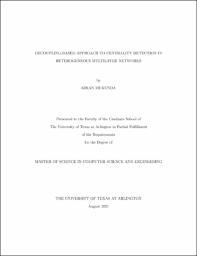
ATTENTION: The works hosted here are being migrated to a new repository that will consolidate resources, improve discoverability, and better show UTA's research impact on the global community. We will update authors as the migration progresses. Please see MavMatrix for more information.
Show simple item record
| dc.contributor.advisor | Chakravarthy, Sharma | |
| dc.creator | Mukunda, Kiran | |
| dc.date.accessioned | 2021-09-14T16:42:29Z | |
| dc.date.available | 2021-09-14T16:42:29Z | |
| dc.date.created | 2021-08 | |
| dc.date.issued | 2021-08-13 | |
| dc.date.submitted | August 2021 | |
| dc.identifier.uri | http://hdl.handle.net/10106/30039 | |
| dc.description.abstract | Graph analysis is one of the techniques widely used for data analysis. It is used extensively on single graphs. Its ability to capture entities and relationships makes it an attractive data model. Search on graphs, such as finding triangles, cliques, shortest paths, etc., and aggregate analysis, such as communities, substructure, or centrality measures have well-defined algorithms for single graphs. The centrality measure, which is the focus of this thesis, identifies the most important nodes in a graph or network. While there are many centrality measures, the most commonly used ones are degree and betweenness centrality. Algorithms for analyzing these measures are numerous for single graphs.
In addition to graphs, multilayer networks (MLNs) are being used to model complex data sets. MLNs consist of several layers, each being a graph. If there are different types of entities in each layer and inter-layer edges are present, then the network is an example of a Heterogeneous Multilayer Network (HeMLN). Due to the lack of algorithms for HeMLNs, they are currently analyzed using aggregation of HeMLN layers including inter-layer edges into a single graph. An alternative projection-based approach is also used to analyze HeMLNs by transforming it into a single graph.
A decoupling-based framework has been proposed to avoid aggregation or projection and still obtain accurate results. This approach analyses the layers independently and composes the partial results to obtain results for a HeMLN. These algorithms have been shown to produce accurate results and are also efficient. Another advantage of this approach is that the layers can be analyzed in parallel. The composition algorithm produces the results of the entire HeMLN. To the best of our knowledge, there are no algorithms that compute centrality measures directly on HeMLNs. This thesis focuses on developing decoupling-based algorithms for degree and betweenness centrality measures for HeMLNs.
The challenge is to minimize the amount of information retained from each layer for use during composition to maximize accuracy. Also, keep the algorithm more efficient than its single graph counterpart, which is considered as the ground truth. This thesis proposes different heuristics and compares the results with the ground truth and naive algorithm. The proposed heuristics consistently improve the accuracy as compared to the naive algorithm while taking less time than the single graph approach.
Finally, the algorithms proposed in the thesis are tested against both real-world and synthetic data sets with different graph characteristics. This is important to demonstrate the efficacy of heuristics on an arbitrary graph. The results obtained are analyzed in detail to empirically establish the heuristic performance in terms of accuracy, time, and space complexity. | |
| dc.format.mimetype | application/pdf | |
| dc.language.iso | en_US | |
| dc.subject | Multilayer network analysis | |
| dc.subject | Degree centrality | |
| dc.subject | Betweenness centrality | |
| dc.title | DECOUPLING-BASED APPROACH TO CENTRALITY DETECTION IN HETEROGENEOUS MULTILAYER NETWORKS | |
| dc.type | Thesis | |
| dc.degree.department | Computer Science and Engineering | |
| dc.degree.name | Master of Science in Computer Science | |
| dc.date.updated | 2021-09-14T16:42:29Z | |
| thesis.degree.department | Computer Science and Engineering | |
| thesis.degree.grantor | The University of Texas at Arlington | |
| thesis.degree.level | Masters | |
| thesis.degree.name | Master of Science in Computer Science | |
| dc.type.material | text | |
| dc.creator.orcid | 0000-0001-7801-5227 | |
Files in this item
- Name:
- MUKUNDA-THESIS-2021.pdf
- Size:
- 3.173Mb
- Format:
- PDF
This item appears in the following Collection(s)
Show simple item record


